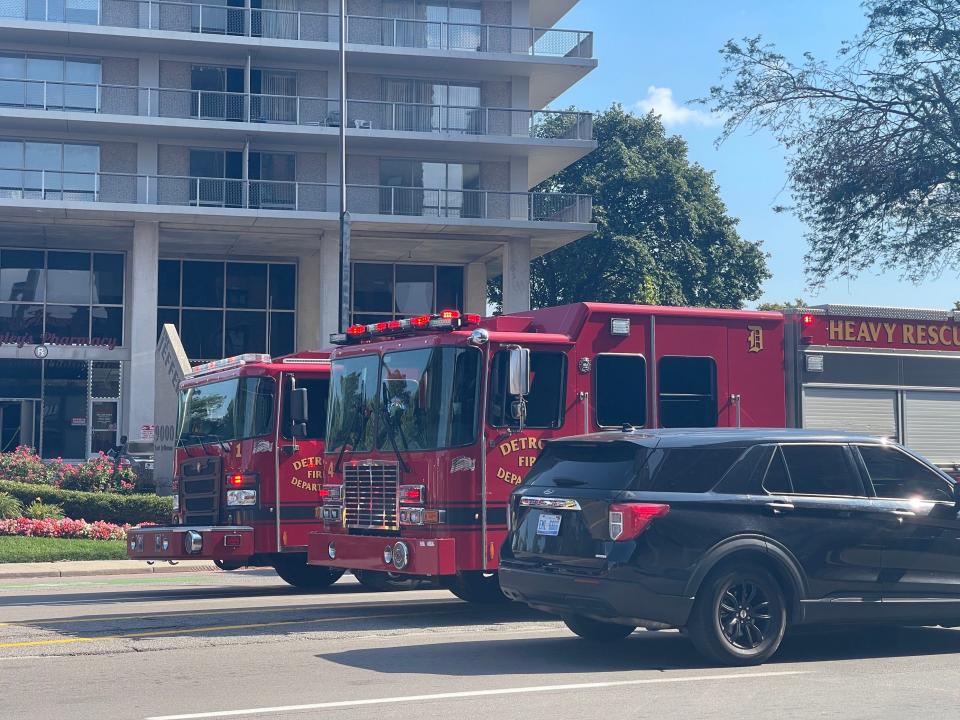Detroit police chief: Everything was done that could have to prevent high-rise suicide
Two days after a 30-year-old woman died, falling 25-floors from a Detroit high-rise apartment building, the Detroit Police Chief said she "suffered from a history of mental illness" and "made the decision to take her own life."
He added in an email to the Free Press sent late Thursday that for about 11 hours, the woman went from "moments of clarity and optimism" to "expressions of hopelessness" and he is confident everything was done that could have "to prevent this tragedy."
Police, firefighters and paramedics nationwide have had to deal with many suicide situations over the years, and the numbers suggest they are increasing. Some cases, like the one in Detroit, have been public; most, however, are not. And too many are over even before rescuers arrive.

In 2021, the latest year data was available, there were 48,183 suicides in America, the highest number recorded since 2018, according to the U.S. Centers of Disease Control and Prevention. Of those, the state's Suicide Prevention Commission's annual report noted, there were 1,482 in Michigan.
To put those numbers in context, suicide is the nation's 11th-leading cause of death, the second-leading cause among people aged 10–34 and the fifth, among those 35–54, according to the CDC. While suicide is seen as the result of a mental health disorder, the CDC emphasized it rarely is the result of one factor.
"Our suicide rate is now near the highest level we’ve seen in the last two decades," Michigan's Suicide Prevention Commission's Co-Chairs Brian Ahmedani and Nancy Buyle wrote. And yet, they added: "We remain optimistic about the opportunities in front of us."
Still, the grief and concerns surrounding suicide linger.
"We really wanted a better outcome — a different outcome — to get this young lady the help she needed," Detroit Police Chief James White told WJBK-TV (Channel 2) Wednesday. "My heart goes out to her mom. I talked to her last night, and she was very brave and very strong, but you can see she was broken."
Weighing potential harm
Understanding and discussing suicide has long been a challenge for loved ones, first responders, school officials, religious leaders and journalists. It is an emotional, private and for some, a taboo topic, to talk about.
Police and fire departments tend to limit what details they release. Schools struggle with how to help students cope. And journalists weigh the harm of reporting suicides against the benefit of holding people accountable and preventing them.
Studies on suicide have shown when news reports describe how these deaths unfold in graphic detail, using sensational headlines and images, it often leads to more of them. So when suicides do occur, the accounts often go unreported.
At the same time — and this is where the optimism and opportunities comes in — experts, including those at Columbia University's graduate school of journalism, note that more open conversation and thoughtful media reporting can "change public misperceptions and correct myths, which can encourage those who are vulnerable or at risk to seek help."

White added the "tragic situation highlights the need to ensure that mental health resources are more widely available and that everyone does their part to remove the stigma that seems to be associated with mental health treatments."
As preventive measures, September has been designated as National Suicide Prevention Month, and there's now a national hotline, 988, for folks who many be thinking about taking their lives and need someone to talk to, reconsider what they are doing and get help can call.
Asking hard questions
Still, as a public safety and public health matter, there are still questions.
One upset Free Press reader emailed to ask why first-responders didn't attempt to pull the woman at the Jeffersonian Apartments away from the edge. And questioned why firefighters weren't "positioned with something to catch her" — a net, air bag or foam mattress ― below?
The Free Press sent a written list of questions to the police and requested, through state Freedom of Information laws, to see the incident report with the hope more specifics might offer insight on how a different response could have resulted in, as the chief said he hoped for, a "different outcome."
While Chief White didn't detail the rescue plan Tuesday, he briefly addressed what he framed as a dilemma: Whether or not to attempt to physically restrain the woman 25 floors up who might jump. He explained what officials decided to do.
"We're going to wait her out," he said, eight hours into negotiations with her, sounding hopeful that she could be talked off the balcony. "But we've got the be careful with that. We've got to watch for, you know, nuances and changes in her behavior that necessitates us moving in."
White had said earlier in the day that the woman was depressed and had taken medication. He did not identify what kind of medication it was or how it might be affecting her. But later, he said, she began showing signs she wanted to live. For one, she began talking about the future.
Leaping to their deaths
Nearly two decades ago, the Free Press wrote about an unusually high number of people who had been leaping to their deaths from overpass bridges and what it meant, not only for those attempting to take their own lives, but also the first responders who tried to save them.
The 2004 report pointed out there were 1,095 suicides in 2002, the most in three years. That was 387 fewer suicides than in 2021. An at the time, similar to now with the pandemic, many were concerned that Americans had just been through national trauma, the 9/11 attacks.
Big bridges — especially better known ones such as the 220-foot-high Golden Gate Bridge in San Francisco and 130-foot-high Prince Edward Viaduct in Toronto — had long been places where people have gone to take their own lives, jumping from 20- and 30-foot overpasses into oncoming traffic was uncommon.
It also, suicide experts said, was a more aggressive way to die, forcing those below to participate.
In some of those suicide attempts, police were able to coax people away from the overpass, even risking their own lives to do so. In one case, two Michigan State Police troopers saved a 26-year-old mom who said she had lost all hope.
One of the troopers wrapped his arms around the woman poised to go over. When he did, she tried to jump. They both teetered on the edge. The other trooper lunged at them both. Somehow, he managed to hold on tight to both of them, steady himself and keep them all from falling to their deaths.
In another case, in 2018, a man tried to leap from an Interstate 696 overpass near Coolidge. But State Police troopers arranged for more than a dozen truckers to stop, side-by-side, under the bridge, to create a barrier, limiting the distance the jumper could fall.
BREAKING: I-696 CLOSED both sides right now at Coolidge. In an effort to stop a man from jumping off overpass, these trucks packed in closely. @FOX2News @1003WNIC pic.twitter.com/L6FQylV5kQ
— Jay Towers (@JayTowers) April 24, 2018
The troopers then talked the man down, likely saving his life.
Tremendous heartbreak
A few months after the 2004 report on overpass deaths ran, another suicide case in the Free Press recounted how Waterford Police officers were unable to save one of their own from taking not only his own life — but the life of his family, too.
The officer was under investigation for theft, suspended and sent home. Sometime, perhaps in the middle of the night or early morning, he shot his 40-year-old wife, their 9-year-old son, both in the temple and at close range, and then the family's small dog.
He turned their house into a inferno and turned the gun on himself.
In 2019, Washtenaw County Sheriff's Deputies went looking for a 56-year-old Superior Township man who seemed to disappear. For 30 years, he never missed work and then suddenly seemed to vanish without a trace. His body was later uncovered in a wooded area of Van Buren Township.
Experiencing thoughts of suicide? These Michigan, national resources can help
Authorities concluded he hung himself.
At the time, in unrelated cases, two other missing men's bodies were found, which likely were suicides.
In many ways, it must have brought relief to their families — and investigators looking for them — to know they were no longer missing. But it also left them with tremendous heartbreak.
And with every suicide that family, friends, first responders, health professionals, teachers, witnesses and even reporters try to prevent, it is painful for them to wonder, when there is a death, what more could have been done.
Contact Frank Witsil: 313-222-5022 or fwitsil@freepress.com. Reporters Chanel Stitt, Bill Laytner and Andrea May Sahouri contributed.
This article originally appeared on Detroit Free Press: Michigan suicide increase affects those struggling to prevent them

